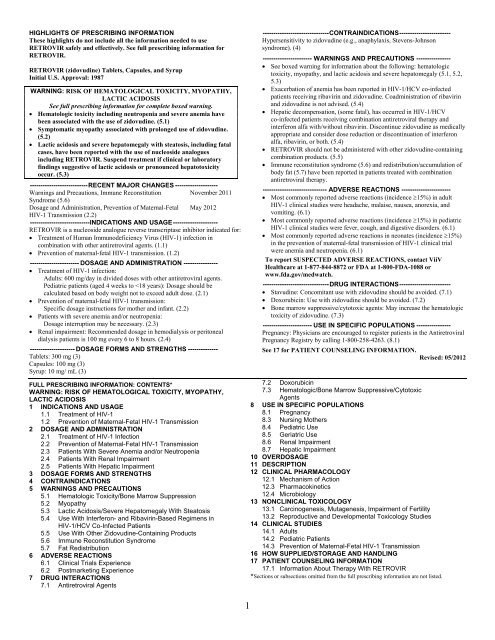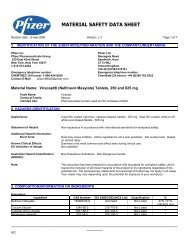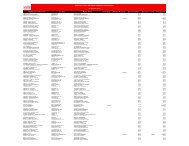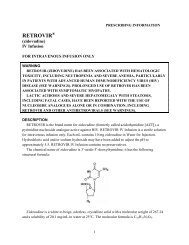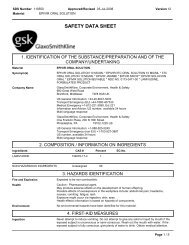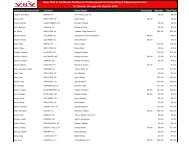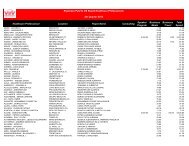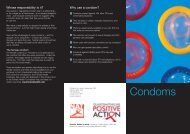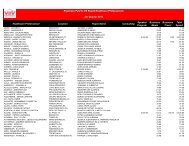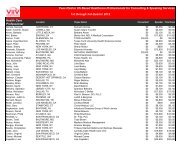Prescribing Information for Retrovir oral - ViiV Healthcare
Prescribing Information for Retrovir oral - ViiV Healthcare
Prescribing Information for Retrovir oral - ViiV Healthcare
You also want an ePaper? Increase the reach of your titles
YUMPU automatically turns print PDFs into web optimized ePapers that Google loves.
HIGHLIGHTS OF PRESCRIBING INFORMATION<br />
These highlights do not include all the in<strong>for</strong>mation needed to use<br />
RETROVIR safely and effectively. See full prescribing in<strong>for</strong>mation <strong>for</strong><br />
RETROVIR.<br />
RETROVIR (zidovudine) Tablets, Capsules, and Syrup<br />
Initial U.S. Approval: 1987<br />
WARNING: RISK OF HEMATOLOGICAL TOXICITY, MYOPATHY,<br />
LACTIC ACIDOSIS<br />
See full prescribing in<strong>for</strong>mation <strong>for</strong> complete boxed warning.<br />
• Hematologic toxicity including neutropenia and severe anemia have<br />
been associated with the use of zidovudine. (5.1)<br />
• Symptomatic myopathy associated with prolonged use of zidovudine.<br />
(5.2)<br />
• Lactic acidosis and severe hepatomegaly with steatosis, including fatal<br />
cases, have been reported with the use of nucleoside analogues<br />
including RETROVIR. Suspend treatment if clinical or laboratory<br />
findings suggestive of lactic acidosis or pronounced hepatotoxicity<br />
occur. (5.3)<br />
--------------------------- RECENT MAJOR CHANGES --------------------<br />
Warnings and Precautions, Immune Reconstitution November 2011<br />
Syndrome (5.6)<br />
Dosage and Administration, Prevention of Maternal-Fetal May 2012<br />
HIV-1 Transmission (2.2)<br />
----------------------------INDICATIONS AND USAGE ---------------------<br />
RETROVIR is a nucleoside analogue reverse transcriptase inhibitor indicated <strong>for</strong>:<br />
• Treatment of Human Immunodeficiency Virus (HIV-1) infection in<br />
combination with other antiretroviral agents. (1.1)<br />
• Prevention of maternal-fetal HIV-1 transmission. (1.2)<br />
----------------------- DOSAGE AND ADMINISTRATION ----------------<br />
• Treatment of HIV-1 infection:<br />
Adults: 600 mg/day in divided doses with other antiretroviral agents.<br />
Pediatric patients (aged 4 weeks to
______________________________________________________________________<br />
FULL PRESCRIBING INFORMATION<br />
WARNING: RISK OF HEMATOLOGICAL TOXICITY, MYOPATHY, LACTIC<br />
ACIDOSIS<br />
Hematologic Toxicity: RETROVIR ® (zidovudine) Tablets, Capsules, and Syrup have<br />
been associated with hematologic toxicity including neutropenia and severe anemia,<br />
particularly in patients with advanced HIV-1 disease [see Warnings and Precautions (5.1)].<br />
Myopathy: Prolonged use of RETROVIR has been associated with symptomatic myopathy<br />
[see Warnings and Precautions (5.2)].<br />
Lactic Acidosis and Severe Hepatomegaly: Lactic acidosis and severe hepatomegaly<br />
with steatosis, including fatal cases, have been reported with the use of nucleoside<br />
analogues alone or in combination, including RETROVIR and other antiretrovirals.<br />
Suspend treatment if clinical or laboratory findings suggestive of lactic acidosis or<br />
pronounced hepatotoxicity occur [see Warnings and Precautions (5.3)].<br />
1 INDICATIONS AND USAGE<br />
1.1 Treatment of HIV-1<br />
RETROVIR, a nucleoside reverse transcriptase inhibitor, is indicated in combination with<br />
other antiretroviral agents <strong>for</strong> the treatment of HIV-1 infection.<br />
1.2 Prevention of Maternal-Fetal HIV-1 Transmission<br />
RETROVIR is indicated <strong>for</strong> the prevention of maternal-fetal HIV-1 transmission [see<br />
Dosage and Administration (2.2)]. The indication is based on a dosing regimen that included<br />
3 components:<br />
1. antepartum therapy of HIV-1 infected mothers<br />
2. intrapartum therapy of HIV-1 infected mothers<br />
3. post-partum therapy of HIV-1 exposed neonate.<br />
Points to consider prior to initiating RETROVIR in pregnant women <strong>for</strong> the prevention of<br />
maternal-fetal HIV-1 transmission include:<br />
• In most cases, RETROVIR <strong>for</strong> prevention of maternal-fetal HIV-1 transmission should be<br />
given in combination with other antiretroviral drugs.<br />
• Prevention of HIV-1 transmission in women who have received RETROVIR <strong>for</strong> a prolonged<br />
period be<strong>for</strong>e pregnancy has not been evaluated.<br />
• Because the fetus is most susceptible to the potential teratogenic effects of drugs during the<br />
first 10 weeks of gestation and the risks of therapy with RETROVIR during that period are<br />
not fully known, women in the first trimester of pregnancy who do not require immediate<br />
initiation of antiretroviral therapy <strong>for</strong> their own health may consider delaying use; this<br />
indication is based on use after 14 weeks gestation.<br />
2
2 DOSAGE AND ADMINISTRATION<br />
2.1 Treatment of HIV-1 Infection<br />
Adults: The recommended <strong>oral</strong> dose of RETROVIR is 600 mg/day in divided doses in<br />
combination with other antiretroviral agents.<br />
Pediatric Patients (Aged 4 Weeks to
Table 2. Recommended Neonatal Dosages of RETROVIR<br />
Route Total Daily Dose Dose and Dosage Regimen<br />
Oral 8 mg/kg/day 2 mg/kg every 6 hours<br />
IV 6 mg/kg/day 1.5 mg/kg infused over 30 minutes, every 6 hours<br />
2.3 Patients With Severe Anemia and/or Neutropenia<br />
Significant anemia (hemoglobin 25% of baseline) and/or<br />
significant neutropenia (granulocyte count 50% from baseline)<br />
may require a dose interruption until evidence of marrow recovery is observed [see Warnings<br />
and Precautions (5.1)]. In patients who develop significant anemia, dose interruption does not<br />
necessarily eliminate the need <strong>for</strong> transfusion. If marrow recovery occurs following dose<br />
interruption, resumption in dose may be appropriate using adjunctive measures such as epoetin<br />
alfa at recommended doses, depending on hematologic indices such as serum erythropoetin level<br />
and patient tolerance.<br />
2.4 Patients With Renal Impairment<br />
End-Stage Renal Disease: In patients maintained on hemodialysis or peritoneal<br />
dialysis, the recommended dosage is 100 mg every 6 to 8 hours [see Clinical Pharmacology<br />
(12.3)].<br />
2.5 Patients With Hepatic Impairment<br />
There are insufficient data to recommend dose adjustment of RETROVIR in patients with<br />
mild to moderate impaired hepatic function or liver cirrhosis.<br />
3 DOSAGE FORMS AND STRENGTHS<br />
RETROVIR Tablets 300 mg (biconvex, white, round, film-coated) containing 300 mg<br />
zidovudine, one side engraved “GX CW3” and “300” on the other side.<br />
RETROVIR Capsules 100 mg (white, opaque cap and body) containing 100 mg<br />
zidovudine and printed with “Wellcome” and unicorn logo on cap and “Y9C” and “100” on<br />
body.<br />
RETROVIR Syrup (colorless to pale yellow, strawberry-flavored) containing 10 mg<br />
zidovudine in each mL.<br />
4 CONTRAINDICATIONS<br />
RETROVIR Tablets, Capsules, and Syrup are contraindicated in patients who have had<br />
potentially life-threatening allergic reactions (e.g., anaphylaxis, Stevens-Johnson syndrome) to<br />
any of the components of the <strong>for</strong>mulations.<br />
5 WARNINGS AND PRECAUTIONS<br />
5.1 Hematologic Toxicity/Bone Marrow Suppression<br />
RETROVIR should be used with caution in patients who have bone marrow compromise<br />
evidenced by granulocyte count
most significant adverse events observed. In patients who experience hematologic toxicity, a<br />
reduction in hemoglobin may occur as early as 2 to 4 weeks, and neutropenia usually occurs after<br />
6 to 8 weeks. There have been reports of pancytopenia associated with the use of RETROVIR,<br />
which was reversible in most instances after discontinuance of the drug. However, significant<br />
anemia, in many cases requiring dose adjustment, discontinuation of RETROVIR, and/or blood<br />
transfusions, has occurred during treatment with RETROVIR alone or in combination with other<br />
antiretrovirals.<br />
Frequent blood counts are strongly recommended to detect severe anemia or neutropenia<br />
in patients with poor bone marrow reserve, particularly in patients with advanced HIV-1 disease<br />
who are treated with RETROVIR. For HIV-1-infected individuals and patients with<br />
asymptomatic or early HIV-1 disease, periodic blood counts are recommended. If anemia or<br />
neutropenia develops, dosage interruption may be needed [see Dosage and Administration<br />
(2.3)].<br />
5.2 Myopathy<br />
Myopathy and myositis with pathological changes, similar to that produced by HIV-1<br />
disease, have been associated with prolonged use of RETROVIR.<br />
5.3 Lactic Acidosis/Severe Hepatomegaly With Steatosis<br />
Lactic acidosis and severe hepatomegaly with steatosis, including fatal cases, have been<br />
reported with the use of nucleoside analogues alone or in combination, including zidovudine and<br />
other antiretrovirals. A majority of these cases have been in women. Obesity and prolonged<br />
exposure to antiretroviral nucleoside analogues may be risk factors. Particular caution should be<br />
exercised when administering RETROVIR to any patient with known risk factors <strong>for</strong> liver<br />
disease; however, cases have also been reported in patients with no known risk factors.<br />
Treatment with RETROVIR should be suspended in any patient who develops clinical or<br />
laboratory findings suggestive of lactic acidosis or pronounced hepatotoxicity (which may<br />
include hepatomegaly and steatosis even in the absence of marked transaminase elevations).<br />
5.4 Use With Interferon- and Ribavirin-Based Regimens in HIV-1/HCV<br />
Co-Infected Patients<br />
In vitro studies have shown ribavirin can reduce the phosphorylation of pyrimidine<br />
nucleoside analogues such as zidovudine. Although no evidence of a pharmacokinetic or<br />
pharmacodynamic interaction (e.g., loss of HIV-1/HCV virologic suppression) was seen when<br />
ribavirin was coadministered with zidovudine in HIV-1/HCV co-infected patients [see Clinical<br />
Pharmacology (12.3)], exacerbation of anemia due to ribavirin has been reported when<br />
zidovudine is part of the HIV regimen. Coadministration of ribavirin and zidovudine is not<br />
advised. Consideration should be given to replacing zidovudine in established combination<br />
HIV-1/HCV therapy, especially in patients with a known history of zidovudine-induced anemia.<br />
Hepatic decompensation (some fatal) has occurred in HIV-1/HCV co-infected patients<br />
receiving combination antiretroviral therapy <strong>for</strong> HIV-1 and interferon alfa with or without<br />
ribavirin. Patients receiving interferon alfa with or without ribavirin and zidovudine should be<br />
5
closely monitored <strong>for</strong> treatment-associated toxicities, especially hepatic decompensation,<br />
neutropenia, and anemia.<br />
Discontinuation of zidovudine should be considered as medically appropriate. Dose<br />
reduction or discontinuation of interferon alfa, ribavirin, or both should also be considered if<br />
worsening clinical toxicities are observed, including hepatic decompensation (e.g., Child-Pugh<br />
>6) (see the complete prescribing in<strong>for</strong>mation <strong>for</strong> interferon and ribavirin).<br />
5.5 Use With Other Zidovudine-Containing Products<br />
RETROVIR should not be administered with combination products that contain<br />
zidovudine as one of their components (e.g., COMBIVIR ® [lamivudine and zidovudine] Tablets<br />
or TRIZIVIR ® [abacavir sulfate, lamivudine, and zidovudine] Tablets).<br />
5.6 Immune Reconstitution Syndrome<br />
Immune reconstitution syndrome has been reported in patients treated with combination<br />
antiretroviral therapy, including RETROVIR. During the initial phase of combination<br />
antiretroviral treatment, patients whose immune systems respond may develop an inflammatory<br />
response to indolent or residual opportunistic infections (such as Mycobacterium avium<br />
infection, cytomegalovirus, Pneumocystis jirovecii pneumonia [PCP], or tuberculosis), which<br />
may necessitate further evaluation and treatment.<br />
Autoimmune disorders (such as Graves’ disease, polymyositis, and Guillain-Barré<br />
syndrome) have also been reported to occur in the setting of immune reconstitution, however, the<br />
time to onset is more variable, and can occur many months after initiation of treatment.<br />
5.7 Fat Redistribution<br />
Redistribution/accumulation of body fat, including central obesity, dorsocervical fat<br />
enlargement (buffalo hump), peripheral wasting, facial wasting, breast enlargement, and<br />
“cushingoid appearance,” have been observed in patients receiving antiretroviral therapy. The<br />
mechanism and long-term consequences of these events are currently unknown. A causal<br />
relationship has not been established.<br />
6 ADVERSE REACTIONS<br />
The following adverse reactions are discussed in greater detail in other sections of the<br />
labeling:<br />
• Hematologic toxicity, including neutropenia and anemia [see Boxed Warning, Warnings and<br />
Precautions (5.1)].<br />
• Symptomatic myopathy [see Boxed Warning, Warnings and Precautions (5.2)].<br />
• Lactic acidosis and severe hepatomegaly with steatosis [see Boxed Warning, Warnings and<br />
Precautions (5.3)].<br />
• Hepatic decompensation in patients co-infected with HIV-1 and hepatitis C [see Warnings<br />
and Precautions (5.4)].<br />
6.1 Clinical Trials Experience<br />
6
Because clinical trials are conducted under widely varying conditions, adverse reaction<br />
rates observed in the clinical trials of a drug cannot be directly compared to rates in the clinical<br />
trials of another drug and may not reflect the rates observed in practice.<br />
Adults: The frequency and severity of adverse reactions associated with the use of<br />
RETROVIR are greater in patients with more advanced infection at the time of initiation of<br />
therapy.<br />
Table 3 summarizes events reported at a statistically significant greater incidence <strong>for</strong><br />
patients receiving RETROVIR in a monotherapy study.<br />
Table 3. Percentage (%) of Patients With Adverse Reactions a in Asymptomatic HIV-1<br />
Infection (ACTG 019)<br />
Adverse Reaction<br />
RETROVIR 500 mg/day<br />
(n = 453)<br />
Placebo<br />
(n = 428)<br />
Body as a whole<br />
Asthenia 9% b 6%<br />
Headache 63% 53%<br />
Malaise 53% 45%<br />
Gastrointestinal<br />
Anorexia 20% 11%<br />
Constipation 6% b 4%<br />
Nausea 51% 30%<br />
Vomiting 17% 10%<br />
a<br />
Reported in ≥5% of study population.<br />
b<br />
Not statistically significant versus placebo.<br />
In addition to the adverse reactions listed in Table 3, adverse reactions observed at an<br />
incidence of ≥5% in any treatment arm in clinical studies (NUCA3001, NUCA3002,<br />
NUCB3001, and NUCB3002) were abdominal cramps, abdominal pain, arthralgia, chills,<br />
dyspepsia, fatigue, insomnia, musculoskeletal pain, myalgia, and neuropathy. Additionally, in<br />
these studies hyperbilirubinemia was reported at an incidence of ≤0.8%.<br />
Selected laboratory abnormalities observed during a clinical study of monotherapy with<br />
RETROVIR are shown in Table 4.<br />
7
Table 4. Frequencies of Selected (Grade 3/4) Laboratory Abnormalities in Patients With<br />
Asymptomatic HIV-1 Infection (ACTG 019)<br />
Test<br />
(Abnormal Level)<br />
RETROVIR 500 mg/day<br />
(n = 453)<br />
Placebo<br />
(n = 428)<br />
Anemia (Hgb
Table 5. Selected Clinical Adverse Reactions and Physical Findings (≥5% Frequency) in<br />
Pediatric Patients in Study ACTG 300<br />
EPIVIR plus<br />
Adverse Reaction<br />
RETROVIR<br />
(n = 236)<br />
Didanosine<br />
(n = 235)<br />
Body as a whole<br />
Fever 25% 32%<br />
Digestive<br />
Hepatomegaly 11% 11%<br />
Nausea & vomiting 8% 7%<br />
Diarrhea 8% 6%<br />
Stomatitis 6% 12%<br />
Splenomegaly 5% 8%<br />
Respiratory<br />
Cough 15% 18%<br />
Abnormal breath sounds/wheezing 7% 9%<br />
Ear, Nose, and Throat<br />
Signs or symptoms of ears a 7% 6%<br />
Nasal discharge or congestion 8% 11%<br />
Other<br />
Skin rashes 12% 14%<br />
Lymphadenopathy 9% 11%<br />
a<br />
Includes pain, discharge, erythema, or swelling of an ear.<br />
Selected laboratory abnormalities experienced by therapy-naive (≤56 days of<br />
antiretroviral therapy) pediatric patients are listed in Table 6.<br />
Table 6. Frequencies of Selected (Grade 3/4) Laboratory Abnormalities in Pediatric<br />
Patients in Study ACTG 300<br />
Test<br />
(Abnormal Level)<br />
EPIVIR plus<br />
RETROVIR Didanosine<br />
Neutropenia (ANC2.5 x ULN) 3% 3%<br />
Total amylase (>2.5 x ULN) 3% 3%<br />
ULN = Upper limit of normal.<br />
ANC = Absolute neutrophil count.<br />
9
Macrocytosis was reported in the majority of pediatric patients receiving RETROVIR<br />
180 mg/m 2 every 6 hours in open-label studies. Additionally, adverse reactions reported at an<br />
incidence of
Nervous: Anxiety, confusion, depression, dizziness, loss of mental acuity, mania,<br />
paresthesia, seizures, somnolence, vertigo.<br />
Respiratory: Dyspnea, rhinitis, sinusitis.<br />
Skin: Changes in skin and nail pigmentation, pruritus, Stevens-Johnson syndrome, toxic<br />
epidermal necrolysis, sweat, urticaria.<br />
Special Senses: Amblyopia, hearing loss, photophobia, taste perversion.<br />
Urogenital: Urinary frequency, urinary hesitancy.<br />
7 DRUG INTERACTIONS<br />
7.1 Antiretroviral Agents<br />
Stavudine: Concomitant use of zidovudine with stavudine should be avoided since an<br />
antagonistic relationship has been demonstrated in vitro.<br />
Nucleoside Analogues Affecting DNA Replication: Some nucleoside analogues<br />
affecting DNA replication, such as ribavirin, antagonize the in vitro antiviral activity of<br />
RETROVIR against HIV-1; concomitant use of such drugs should be avoided.<br />
7.2 Doxorubicin<br />
Concomitant use of zidovudine with doxorubicin should be avoided since an antagonistic<br />
relationship has been demonstrated in vitro.<br />
7.3 Hematologic/Bone Marrow Suppressive/Cytotoxic Agents<br />
Coadministration of ganciclovir, interferon alfa, ribavirin, and other bone marrow<br />
suppressive or cytotoxic agents may increase the hematologic toxicity of zidovudine.<br />
8 USE IN SPECIFIC POPULATIONS<br />
8.1 Pregnancy<br />
Pregnancy Category C.<br />
In humans, treatment with RETROVIR during pregnancy reduced the rate of<br />
maternal-fetal HIV-1 transmission from 24.9% <strong>for</strong> infants born to placebo-treated mothers to<br />
7.8% <strong>for</strong> infants born to mothers treated with RETROVIR [see Clinical Studies (14.3)]. There<br />
were no differences in pregnancy-related adverse events between the treatment groups. Animal<br />
reproduction studies in rats and rabbits showed evidence of embryotoxicity and increased fetal<br />
mal<strong>for</strong>mations.<br />
A randomized, double-blind, placebo-controlled trial was conducted in HIV-1-infected<br />
pregnant women to determine the utility of RETROVIR <strong>for</strong> the prevention of maternal-fetal<br />
HIV-1-transmission [see Clinical Studies (14.3)]. Congenital abnormalities occurred with similar<br />
frequency between neonates born to mothers who received RETROVIR and neonates born to<br />
mothers who received placebo. The observed abnormalities included problems in embryogenesis<br />
(prior to 14 weeks) or were recognized on ultrasound be<strong>for</strong>e or immediately after initiation of<br />
study drug.<br />
Increased fetal resorptions occurred in pregnant rats and rabbits treated with doses of<br />
zidovudine that produced drug plasma concentrations 66 to 226 times (rats) and 12 to 87 times<br />
(rabbits) the mean steady-state peak human plasma concentration following a single 100-mg<br />
11
dose of zidovudine. There were no other reported developmental anomalies. In another<br />
developmental toxicity study, pregnant rats received zidovudine up to near-lethal doses that<br />
produced peak plasma concentrations 350 times peak human plasma concentrations (300 times<br />
the daily exposure [AUC] in humans given 600 mg/day zidovudine). This dose was associated<br />
with marked maternal toxicity and an increased incidence of fetal mal<strong>for</strong>mations. However, there<br />
were no signs of teratogenicity at doses up to one-fifth the lethal dose [see Nonclinical<br />
Toxicology (13.2)].<br />
Antiretroviral Pregnancy Registry: To monitor maternal-fetal outcomes of pregnant<br />
women exposed to RETROVIR, an Antiretroviral Pregnancy Registry has been established.<br />
Physicians are encouraged to register patients by calling 1-800-258-4263.<br />
8.3 Nursing Mothers<br />
Zidovudine is excreted in human milk [see Clinical Pharmacology (12.3)].<br />
The Centers <strong>for</strong> Disease Control and Prevention recommend that HIV-1-infected mothers<br />
in the United States not breastfeed their infants to avoid risking postnatal transmission of HIV-1<br />
infection. Because of both the potential <strong>for</strong> HIV-1 transmission and the potential <strong>for</strong> serious<br />
adverse reactions in nursing infants, mothers should be instructed not to breastfeed if they are<br />
receiving RETROVIR.<br />
8.4 Pediatric Use<br />
RETROVIR has been studied in HIV-1-infected pediatric patients ≥6 weeks of age who<br />
had HIV-1-related symptoms or who were asymptomatic with abnormal laboratory values<br />
indicating significant HIV-1-related immunosuppression. RETROVIR has also been studied in<br />
neonates perinatally exposed to HIV-1 [see Dosage and Administration (2.1), Adverse Reactions<br />
(6.1), Clinical Pharmacology (12.3), Clinical Studies (14.2), (14.3)].<br />
8.5 Geriatric Use<br />
Clinical studies of RETROVIR did not include sufficient numbers of subjects aged 65<br />
and over to determine whether they respond differently from younger subjects. Other reported<br />
clinical experience has not identified differences in responses between the elderly and younger<br />
patients. In general, dose selection <strong>for</strong> an elderly patient should be cautious, reflecting the greater<br />
frequency of decreased hepatic, renal, or cardiac function, and of concomitant disease or other<br />
drug therapy.<br />
8.6 Renal Impairment<br />
In patients with severely impaired renal function (CrCl
10 OVERDOSAGE<br />
Acute overdoses of zidovudine have been reported in pediatric patients and adults. These<br />
involved exposures up to 50 grams. No specific symptoms or signs have been identified<br />
following acute overdosage with zidovudine apart from those listed as adverse events such as<br />
fatigue, headache, vomiting, and occasional reports of hematological disturbances. All patients<br />
recovered without permanent sequelae. Hemodialysis and peritoneal dialysis appear to have a<br />
negligible effect on the removal of zidovudine while elimination of its primary metabolite, 3′-<br />
azido-3′-deoxy-5′-O-β-D-glucopyranuronosylthymidine (GZDV), is enhanced.<br />
11 DESCRIPTION<br />
RETROVIR is the brand name <strong>for</strong> zidovudine (<strong>for</strong>merly called azidothymidine [AZT]), a<br />
pyrimidine nucleoside analogue active against HIV-1. The chemical name of zidovudine is 3′-<br />
azido-3′-deoxythymidine; it has the following structural <strong>for</strong>mula:<br />
Zidovudine is a white to beige, odorless, crystalline solid with a molecular weight of<br />
267.24 and a solubility of 20.1 mg/mL in water at 25°C. The molecular <strong>for</strong>mula is C 10 H 13 N 5 O 4 .<br />
RETROVIR Tablets are <strong>for</strong> <strong>oral</strong> administration. Each film-coated tablet contains 300 mg<br />
of zidovudine and the inactive ingredients hypromellose, magnesium stearate, microcrystalline<br />
cellulose, polyethylene glycol, sodium starch glycolate, and titanium dioxide.<br />
RETROVIR Capsules are <strong>for</strong> <strong>oral</strong> administration. Each capsule contains 100 mg of<br />
zidovudine and the inactive ingredients corn starch, magnesium stearate, microcrystalline<br />
cellulose, and sodium starch glycolate. The 100-mg empty hard gelatin capsule, printed with<br />
edible black ink, consists of black iron oxide, dimethylpolysiloxane, gelatin, pharmaceutical<br />
shellac, soya lecithin, and titanium dioxide.<br />
RETROVIR Syrup is <strong>for</strong> <strong>oral</strong> administration. Each mL of RETROVIR Syrup contains<br />
10 mg of zidovudine and the inactive ingredients sodium benzoate 0.2% (added as a<br />
preservative), citric acid, flavors, glycerin, and liquid sucrose. Sodium hydroxide may be added<br />
to adjust pH.<br />
12 CLINICAL PHARMACOLOGY<br />
12.1 Mechanism of Action<br />
Zidovudine is an antiviral agent [see Clinical Pharmacology (12.4)].<br />
12.3 Pharmacokinetics<br />
13
Absorption and Bioavailability: In adults, following <strong>oral</strong> administration, zidovudine is<br />
rapidly absorbed and extensively distributed, with peak serum concentrations occurring within<br />
0.5 to 1.5 hours. The AUC was equivalent when zidovudine was administered as RETROVIR<br />
Tablets or Syrup compared with RETROVIR Capsules. The pharmacokinetic properties of<br />
zidovudine in fasting adult patients are summarized in Table 7.<br />
Table 7. Zidovudine Pharmacokinetic Parameters in Fasting Adult Patients<br />
Mean ± SD<br />
Parameter<br />
(except where noted)<br />
Oral bioavailability (%) 64 ± 10<br />
(n = 5)<br />
Apparent volume of distribution (L/kg) 1.6 ± 0.6<br />
(n = 8)<br />
Plasma protein binding (%)
function (n = 14) following a single 200-mg <strong>oral</strong> dose (Table 8). Plasma concentrations of AMT<br />
were not determined. A dose adjustment should not be necessary <strong>for</strong> patients with creatinine<br />
clearance (CrCl) ≥15 mL/min.<br />
Table 8. Zidovudine Pharmacokinetic Parameters in Patients With Severe Renal<br />
Impairment a<br />
Control Subjects<br />
(Normal Renal Function)<br />
(n = 6)<br />
Patients With Renal<br />
Impairment<br />
(n = 14)<br />
Parameter<br />
CrCl (mL/min) 120 ± 8 18 ± 2<br />
Zidovudine AUC (ng•hr/mL) 1,400 ± 200 3,100 ± 300<br />
Zidovudine half-life (hr) 1.0 ± 0.2 1.4 ± 0.1<br />
a<br />
Data are expressed as mean ± standard deviation.<br />
Hemodialysis and Peritoneal Dialysis: The pharmacokinetics and tolerance of<br />
zidovudine were evaluated in a multiple-dose study in patients undergoing hemodialysis (n = 5)<br />
or peritoneal dialysis (n = 6) receiving escalating doses up to 200 mg 5 times daily <strong>for</strong> 8 weeks.<br />
Daily doses of 500 mg or less were well tolerated despite significantly elevated GZDV plasma<br />
concentrations. Apparent zidovudine <strong>oral</strong> clearance was approximately 50% of that reported in<br />
patients with normal renal function. Hemodialysis and peritoneal dialysis appeared to have a<br />
negligible effect on the removal of zidovudine, whereas GZDV elimination was enhanced. A<br />
dosage adjustment is recommended <strong>for</strong> patients undergoing hemodialysis or peritoneal dialysis<br />
[see Dosage and Administration (2.4)].<br />
Hepatic Impairment: Data describing the effect of hepatic impairment on the<br />
pharmacokinetics of zidovudine are limited. However, because zidovudine is eliminated<br />
primarily by hepatic metabolism, it is expected that zidovudine clearance would be decreased<br />
and plasma concentrations would be increased following administration of the recommended<br />
adult doses to patients with hepatic impairment [see Dosage and Administration (2.5)].<br />
Pediatric Patients: Zidovudine pharmacokinetics have been evaluated in<br />
HIV-1-infected pediatric patients (Table 9).<br />
Patients Aged 3 Months to 12 Years: Overall, zidovudine pharmacokinetics in<br />
pediatric patients greater than 3 months of age are similar to those in adult patients. Proportional<br />
increases in plasma zidovudine concentrations were observed following administration of <strong>oral</strong><br />
solution from 90 to 240 mg/m 2 every 6 hours. Oral bioavailability, terminal half-life, and <strong>oral</strong><br />
clearance were comparable to adult values. As in adult patients, the major route of elimination<br />
was by metabolism to GZDV. After intravenous dosing, about 29% of the dose was excreted in<br />
the urine unchanged, and about 45% of the dose was excreted as GZDV [see Dosage and<br />
Administration (2.1)].<br />
Patients Aged Less Than 3 Months: Zidovudine pharmacokinetics have been<br />
evaluated in pediatric patients from birth to 3 months of life. Zidovudine elimination was<br />
15
determined immediately following birth in 8 neonates who were exposed to zidovudine in utero.<br />
The half-life was 13.0 ± 5.8 hours. In neonates ≤14 days old, bioavailability was greater, total<br />
body clearance was slower, and half-life was longer than in pediatric patients >14 days old. For<br />
dose recommendations <strong>for</strong> neonates [see Dosage and Administration (2.2)].<br />
Table 9. Zidovudine Pharmacokinetic Parameters in Pediatric Patients a<br />
Birth to 14 Days Aged 14 Days to Aged 3 Months to<br />
Parameter<br />
3 Months<br />
12 Years<br />
Oral bioavailability (%) 89 ± 19<br />
(n = 15)<br />
61 ± 19<br />
(n = 17)<br />
65 ± 24<br />
(n = 18)<br />
CSF:plasma ratio no data no data 0.68 [0.03 to 3.25] b<br />
a<br />
b<br />
CL (L/hr/kg) 0.65 ± 0.29<br />
(n = 18)<br />
1.14 ± 0.24<br />
(n = 16)<br />
Elimination half-life (hr) 3.1 ± 1.2<br />
1.9 ± 0.7<br />
(n = 21)<br />
(n = 18)<br />
Data presented as mean ± standard deviation except where noted.<br />
Median [range].<br />
(n = 38)<br />
1.85 ± 0.47<br />
(n = 20)<br />
1.5 ± 0.7<br />
(n = 21)<br />
Pregnancy: Zidovudine pharmacokinetics have been studied in a Phase I study of<br />
8 women during the last trimester of pregnancy. Zidovudine pharmacokinetics were similar to<br />
those of nonpregnant adults. Consistent with passive transmission of the drug across the<br />
placenta, zidovudine concentrations in neonatal plasma at birth were essentially equal to those in<br />
maternal plasma at delivery [see Use in Specific Populations (8.1)].<br />
Although data are limited, methadone maintenance therapy in 5 pregnant women did not<br />
appear to alter zidovudine pharmacokinetics.<br />
Nursing Mothers: The Centers <strong>for</strong> Disease Control and Prevention recommend that<br />
HIV-1-infected mothers not breastfeed their infants to avoid risking postnatal transmission of<br />
HIV-1. After administration of a single dose of 200 mg zidovudine to 13 HIV-1-infected women,<br />
the mean concentration of zidovudine was similar in human milk and serum [see Use in Specific<br />
Populations (8.3)].<br />
Geriatric Patients: Zidovudine pharmacokinetics have not been studied in patients<br />
over 65 years of age.<br />
Gender: A pharmacokinetic study in healthy male (n = 12) and female (n = 12)<br />
subjects showed no differences in zidovudine AUC when a single dose of zidovudine was<br />
administered as the 300-mg RETROVIR Tablet.<br />
Drug Interactions: [See Drug Interactions (7)].<br />
16
Table 10. Effect of Coadministered Drugs on Zidovudine AUC a<br />
Note: ROUTINE DOSE MODIFICATION OF ZIDOVUDINE IS NOT WARRANTED<br />
WITH COADMINISTRATION OF THE FOLLOWING DRUGS.<br />
Coadministered Zidovudine<br />
Zidovudine<br />
Concentrations<br />
Concentration of<br />
Coadministered<br />
Drug and Dose Dose n AUC Variability Drug<br />
Atovaquone<br />
750 mg q 12 hr<br />
with food<br />
Clarithromycin<br />
500 mg twice daily<br />
Fluconazole<br />
400 mg daily<br />
Lamivudine<br />
300 mg q 12 hr<br />
Methadone<br />
30 to 90 mg daily<br />
Nelfinavir<br />
750 mg q 8 hr x<br />
7 to 10 days<br />
Probenecid<br />
500 mg q 6 hr x<br />
2 days<br />
Rifampin<br />
600 mg daily x<br />
14 days<br />
Ritonavir<br />
300 mg q 6 hr x<br />
4 days<br />
Valproic acid<br />
250 mg or 500 mg<br />
q 8 hr x 4 days<br />
200 mg q 8 hr 14 ↑AUC<br />
31%<br />
100 mg q 4 hr<br />
x 7 days<br />
4 ↓AUC<br />
12%<br />
200 mg q 8 hr 12 ↑AUC<br />
74%<br />
single 200 mg 12 ↑AUC<br />
13%<br />
200 mg q 4 hr 9 ↑AUC<br />
43%<br />
single 200 mg 11 ↓AUC<br />
35%<br />
2 mg/kg q 8 hr<br />
x 3 days<br />
200 mg q 8 hr<br />
x 14 days<br />
200 mg q 8 hr<br />
x 4 days<br />
100 mg q 8 hr<br />
x 4 days<br />
3 ↑AUC<br />
106%<br />
8 ↓AUC<br />
47%<br />
9 ↓AUC<br />
25%<br />
6 ↑AUC<br />
80%<br />
Range<br />
23% to 78% b ↔<br />
Range Not Reported<br />
↓34% to ↑14%<br />
95% CI: Not Reported<br />
54% to 98%<br />
90% CI:<br />
↔<br />
2% to 27%<br />
Range<br />
↔<br />
16% to 64% b<br />
Range<br />
↔<br />
28% to 41%<br />
Range<br />
100% to 170% b Not Assessed<br />
90% CI:<br />
41% to 53%<br />
95% CI:<br />
15% to 34%<br />
Not Assessed<br />
↔<br />
Range Not Assessed<br />
64% to 130% b<br />
↑ = Increase; ↓ = Decrease; ↔ = no significant change; AUC = area under the concentration<br />
versus time curve; CI = confidence interval.<br />
a<br />
This table is not all inclusive.<br />
b<br />
Estimated range of percent difference.<br />
Phenytoin: Phenytoin plasma levels have been reported to be low in some patients<br />
receiving RETROVIR, while in one case a high level was documented. However, in a<br />
pharmacokinetic interaction study in which 12 HIV-1-positive volunteers received a single<br />
17
300-mg phenytoin dose alone and during steady-state zidovudine conditions (200 mg every<br />
4 hours), no change in phenytoin kinetics was observed. Although not designed to optimally<br />
assess the effect of phenytoin on zidovudine kinetics, a 30% decrease in <strong>oral</strong> zidovudine<br />
clearance was observed with phenytoin.<br />
Ribavirin: In vitro data indicate ribavirin reduces phosphorylation of lamivudine,<br />
stavudine, and zidovudine. However, no pharmacokinetic (e.g., plasma concentrations or<br />
intracellular triphosphorylated active metabolite concentrations) or pharmacodynamic (e.g., loss<br />
of HIV-1/HCV virologic suppression) interaction was observed when ribavirin and lamivudine<br />
(n = 18), stavudine (n = 10), or zidovudine (n = 6) were coadministered as part of a multi-drug<br />
regimen to HIV-1/HCV co-infected patients [see Warnings and Precautions (5.4)].<br />
12.4 Microbiology<br />
Mechanism of Action: Zidovudine is a synthetic nucleoside analogue. Intracellularly,<br />
zidovudine is phosphorylated to its active 5′-triphosphate metabolite, zidovudine triphosphate<br />
(ZDV-TP). The principal mode of action of ZDV-TP is inhibition of reverse transcriptase (RT)<br />
via DNA chain termination after incorporation of the nucleotide analogue. ZDV-TP is a weak<br />
inhibitor of the cellular DNA polymerases α and γ and has been reported to be incorporated into<br />
the DNA of cells in culture.<br />
Antiviral Activity: The antiviral activity of zidovudine against HIV-1 was assessed in a<br />
number of cell lines (including monocytes and fresh human peripheral blood lymphocytes). The<br />
EC 50 and EC 90 values <strong>for</strong> zidovudine were 0.01 to 0.49 µM (1 μM = 0.27 mcg/mL) and 0.1 to<br />
9 μM, respectively. HIV-1 from therapy-naive subjects with no mutations associated with<br />
resistance gave median EC 50 values of 0.011 µM (range: 0.005 to 0.110 µM) from Virco<br />
(n = 92 baseline samples from COL40263) and 0.0017 µM (0.006 to 0.0340 µM) from<br />
Monogram Biosciences (n = 135 baseline samples from ESS30009). The EC 50 values of<br />
zidovudine against different HIV-1 clades (A-G) ranged from 0.00018 to 0.02 μM, and against<br />
HIV-2 isolates from 0.00049 to 0.004 μM. In cell culture drug combination studies, zidovudine<br />
demonstrates synergistic activity with the nucleoside reverse transcriptase inhibitors abacavir,<br />
didanosine, and lamivudine; the non-nucleoside reverse transcriptase inhibitors delavirdine and<br />
nevirapine; and the protease inhibitors indinavir, nelfinavir, ritonavir, and saquinavir; and<br />
additive activity with interferon alfa. Ribavirin has been found to inhibit the phosphorylation of<br />
zidovudine in cell culture.<br />
Resistance: Genotypic analyses of the isolates selected in cell culture and recovered<br />
from zidovudine-treated patients showed mutations in the HIV-1 RT gene resulting in 6 amino<br />
acid substitutions (M41L, D67N, K70R, L210W, T215Y or F, and K219Q) that confer<br />
zidovudine resistance. In general, higher levels of resistance were associated with greater number<br />
of amino acid substitutions. In some patients harboring zidovudine-resistant virus at baseline,<br />
phenotypic sensitivity to zidovudine was restored by 12 weeks of treatment with lamivudine and<br />
zidovudine. Combination therapy with lamivudine plus zidovudine delayed the emergence of<br />
substitutions conferring resistance to zidovudine.<br />
18
Cross-Resistance: In a study of 167 HIV-1-infected patients, isolates (n = 2) with<br />
multi-drug resistance to didanosine, lamivudine, stavudine, zalcitabine, and zidovudine were<br />
recovered from patients treated <strong>for</strong> ≥1 year with zidovudine plus didanosine or zidovudine plus<br />
zalcitabine. The pattern of resistance-associated amino acid substitutions with such combination<br />
therapies was different (A62V, V75I, F77L, F116Y, Q151M) from the pattern with zidovudine<br />
monotherapy, with the Q151M substitution being most commonly associated with multi-drug<br />
resistance. The substitution at codon 151 in combination with substitutions at 62, 75, 77, and 116<br />
results in a virus with reduced susceptibility to didanosine, lamivudine, stavudine, zalcitabine,<br />
and zidovudine. Thymidine analogue mutations (TAMs) are selected by zidovudine and confer<br />
cross-resistance to abacavir, didanosine, stavudine, tenofovir, and zalcitabine.<br />
13 NONCLINICAL TOXICOLOGY<br />
13.1 Carcinogenesis, Mutagenesis, Impairment of Fertility<br />
Zidovudine was administered <strong>oral</strong>ly at 3 dosage levels to separate groups of mice and rats<br />
(60 females and 60 males in each group). Initial single daily doses were 30, 60, and<br />
120 mg/kg/day in mice and 80, 220, and 600 mg/kg/day in rats. The doses in mice were reduced<br />
to 20, 30, and 40 mg/kg/day after day 90 because of treatment-related anemia, whereas in rats<br />
only the high dose was reduced to 450 mg/kg/day on day 91 and then to 300 mg/kg/day on<br />
day 279.<br />
In mice, 7 late-appearing (after 19 months) vaginal neoplasms (5 nonmetastasizing<br />
squamous cell carcinomas, 1 squamous cell papilloma, and 1 squamous polyp) occurred in<br />
animals given the highest dose. One late-appearing squamous cell papilloma occurred in the<br />
vagina of a middle-dose animal. No vaginal tumors were found at the lowest dose.<br />
In rats, 2 late-appearing (after 20 months), nonmetastasizing vaginal squamous cell<br />
carcinomas occurred in animals given the highest dose. No vaginal tumors occurred at the low or<br />
middle dose in rats. No other drug-related tumors were observed in either sex of either species.<br />
At doses that produced tumors in mice and rats, the estimated drug exposure (as<br />
measured by AUC) was approximately 3 times (mouse) and 24 times (rat) the estimated human<br />
exposure at the recommended therapeutic dose of 100 mg every 4 hours.<br />
It is not known how predictive the results of rodent carcinogenicity studies may be <strong>for</strong><br />
humans.<br />
Zidovudine was mutagenic in a 5178Y/TK +/- mouse lymphoma assay, positive in an in<br />
vitro cell trans<strong>for</strong>mation assay, clastogenic in a cytogenetic assay using cultured human<br />
lymphocytes, and positive in mouse and rat micronucleus tests after repeated doses. It was<br />
negative in a cytogenetic study in rats given a single dose.<br />
Zidovudine, administered to male and female rats at doses up to 7 times the usual adult<br />
dose based on body surface area, had no effect on fertility judged by conception rates.<br />
Two transplacental carcinogenicity studies were conducted in mice. One study<br />
administered zidovudine at doses of 20 mg/kg/day or 40 mg/kg/day from gestation day 10<br />
through parturition and lactation with dosing continuing in offspring <strong>for</strong> 24 months postnatally.<br />
19
The doses of zidovudine administered in this study produced zidovudine exposures<br />
approximately 3 times the estimated human exposure at recommended doses. After 24 months,<br />
an increase in incidence of vaginal tumors was noted with no increase in tumors in the liver or<br />
lung or any other organ in either gender. These findings are consistent with results of the<br />
standard <strong>oral</strong> carcinogenicity study in mice, as described earlier. A second study administered<br />
zidovudine at maximum tolerated doses of 12.5 mg/day or 25 mg/day (∼1,000 mg/kg<br />
nonpregnant body weight or ∼450 mg/kg of term body weight) to pregnant mice from days 12<br />
through 18 of gestation. There was an increase in the number of tumors in the lung, liver, and<br />
female reproductive tracts in the offspring of mice receiving the higher dose level of zidovudine.<br />
13.2 Reproductive and Developmental Toxicology Studies<br />
Oral teratology studies in the rat and in the rabbit at doses up to 500 mg/kg/day revealed<br />
no evidence of teratogenicity with zidovudine. Zidovudine treatment resulted in embryo/fetal<br />
toxicity as evidenced by an increase in the incidence of fetal resorptions in rats given 150 or<br />
450 mg/kg/day and rabbits given 500 mg/kg/day. The doses used in the teratology studies<br />
resulted in peak zidovudine plasma concentrations (after one-half of the daily dose) in rats 66 to<br />
226 times, and in rabbits 12 to 87 times, mean steady-state peak human plasma concentrations<br />
(after one-sixth of the daily dose) achieved with the recommended daily dose (100 mg every<br />
4 hours). In an in vitro experiment with fertilized mouse oocytes, zidovudine exposure resulted<br />
in a dose-dependent reduction in blastocyst <strong>for</strong>mation. In an additional teratology study in rats, a<br />
dose of 3,000 mg/kg/day (very near the <strong>oral</strong> median lethal dose in rats of 3,683 mg/kg) caused<br />
marked maternal toxicity and an increase in the incidence of fetal mal<strong>for</strong>mations. This dose<br />
resulted in peak zidovudine plasma concentrations 350 times peak human plasma concentrations.<br />
(Estimated AUC in rats at this dose level was 300 times the daily AUC in humans given<br />
600 mg/day.) No evidence of teratogenicity was seen in this experiment at doses of<br />
600 mg/kg/day or less.<br />
14 CLINICAL STUDIES<br />
Therapy with RETROVIR has been shown to prolong survival and decrease the incidence<br />
of opportunistic infections in patients with advanced HIV-1 disease and to delay disease<br />
progression in asymptomatic HIV-1-infected patients.<br />
14.1 Adults<br />
Combination Therapy: RETROVIR in combination with other antiretroviral agents has<br />
been shown to be superior to monotherapy <strong>for</strong> one or more of the following endpoints: delaying<br />
death, delaying development of AIDS, increasing CD4+ cell counts, and decreasing plasma<br />
HIV-1 RNA.<br />
The clinical efficacy of a combination regimen that includes RETROVIR was<br />
demonstrated in study ACTG 320. This study was a multi-center, randomized, double-blind,<br />
placebo-controlled trial that compared RETROVIR 600 mg/day plus EPIVIR 300 mg/day to<br />
RETROVIR plus EPIVIR plus indinavir 800 mg three times daily. The incidence of AIDS-<br />
20
defining events or death was lower in the triple-drug–containing arm compared with the 2-drug–<br />
containing arm (6.1% versus 10.9%, respectively).<br />
Monotherapy: In controlled studies of treatment-naive patients conducted between 1986<br />
and 1989, monotherapy with RETROVIR, as compared with placebo, reduced the risk of HIV-1<br />
disease progression, as assessed using endpoints that included the occurrence of HIV-1-related<br />
illnesses, AIDS-defining events, or death. These studies enrolled patients with advanced disease<br />
(BW 002), and asymptomatic or mildly symptomatic disease in patients with CD4+ cell counts<br />
between 200 and 500 cells/mm 3 (ACTG 016 and ACTG 019). A survival benefit <strong>for</strong><br />
monotherapy with RETROVIR was not demonstrated in the latter 2 studies. Subsequent studies<br />
showed that the clinical benefit of monotherapy with RETROVIR was time limited.<br />
14.2 Pediatric Patients<br />
ACTG 300 was a multi-center, randomized, double-blind study that provided <strong>for</strong><br />
comparison of EPIVIR plus RETROVIR to didanosine monotherapy. A total of<br />
471 symptomatic, HIV-1-infected therapy-naive pediatric patients were enrolled in these<br />
2 treatment arms. The median age was 2.7 years (range: 6 weeks to 14 years), the mean baseline<br />
CD4+ cell count was 868 cells/mm 3 , and the mean baseline plasma HIV-1 RNA was<br />
5.0 log 10 copies/mL. The median duration that patients remained on study was approximately<br />
10 months. Results are summarized in Table 11.<br />
Table 11. Number of Patients (%) Reaching a Primary Clinical Endpoint (Disease<br />
Progression or Death)<br />
Endpoint<br />
EPIVIR plus RETROVIR<br />
(n = 236)<br />
Didanosine<br />
(n = 235)<br />
HIV disease progression or death (total) 15 (6.4%) 37 (15.7%)<br />
Physical growth failure 7 (3.0%) 6 (2.6%)<br />
Central nervous system deterioration 4 (1.7%) 12 (5.1%)<br />
CDC Clinical Category C 2 (0.8%) 8 (3.4%)<br />
Death 2 (0.8%) 11 (4.7%)<br />
14.3 Prevention of Maternal-Fetal HIV-1 Transmission<br />
The utility of RETROVIR <strong>for</strong> the prevention of maternal-fetal HIV-1 transmission was<br />
demonstrated in a randomized, double-blind, placebo-controlled trial (ACTG 076) conducted in<br />
HIV-1-infected pregnant women with CD4+ cell counts of 200 to 1,818 cells/mm 3 (median in<br />
the treated group: 560 cells/mm 3 ) who had little or no previous exposure to RETROVIR. Oral<br />
RETROVIR was initiated between 14 and 34 weeks of gestation (median 11 weeks of therapy)<br />
followed by IV administration of RETROVIR during labor and delivery. Following birth,<br />
neonates received <strong>oral</strong> RETROVIR Syrup <strong>for</strong> 6 weeks. The study showed a statistically<br />
significant difference in the incidence of HIV-1 infection in the neonates (based on viral culture<br />
from peripheral blood) between the group receiving RETROVIR and the group receiving<br />
placebo. Of 363 neonates evaluated in the study, the estimated risk of HIV-1 infection was 7.8%<br />
21
in the group receiving RETROVIR and 24.9% in the placebo group, a relative reduction in<br />
transmission risk of 68.7%. RETROVIR was well tolerated by mothers and infants. There was<br />
no difference in pregnancy-related adverse events between the treatment groups.<br />
16 HOW SUPPLIED/STORAGE AND HANDLING<br />
RETROVIR Tablets 300 mg (biconvex, white, round, film-coated) containing 300 mg<br />
zidovudine, one side engraved “GX CW3” and “300” on the other side.<br />
Bottle of 60 (NDC 49702-214-18).<br />
Store at 15° to 25°C (59° to 77°F).<br />
RETROVIR Capsules 100 mg (white, opaque cap and body) containing 100 mg<br />
zidovudine and printed with “Wellcome” and unicorn logo on cap and “Y9C” and “100” on<br />
body.<br />
Bottles of 100 (NDC 49702-211-20).<br />
Store at 15° to 25°C (59° to 77°F) and protect from moisture.<br />
RETROVIR Syrup (colorless to pale yellow, strawberry-flavored) containing 10 mg<br />
zidovudine in each mL.<br />
Bottle of 240 mL (NDC 49702-212-48) with child-resistant cap.<br />
Store at 15° to 25°C (59° to 77°F).<br />
17 PATIENT COUNSELING INFORMATION<br />
17.1 Advice <strong>for</strong> the Patient<br />
Neutropenia and Anemia: Patients should be in<strong>for</strong>med that the major toxicities of<br />
RETROVIR are neutropenia and/or anemia. The frequency and severity of these toxicities are<br />
greater in patients with more advanced disease and in those who initiate therapy later in the<br />
course of their infection. Patients should be in<strong>for</strong>med that if toxicity develops, they may require<br />
transfusions or drug discontinuation. Patients should be in<strong>for</strong>med of the extreme importance of<br />
having their blood counts followed closely while on therapy, especially <strong>for</strong> patients with<br />
advanced symptomatic HIV-1 disease [see Boxed Warning, Warnings and Precautions (5.1)].<br />
Myopathy: Patients should be in<strong>for</strong>med that myopathy and myositis with pathological<br />
changes, similar to that produced by HIV-1 disease, have been associated with prolonged use of<br />
RETROVIR [see Boxed Warning, Warnings and Precautions (5.2)].<br />
Lactic Acidosis/Hepatomegaly: Patients should be in<strong>for</strong>med that some HIV medicines,<br />
including RETROVIR, can cause a rare, but serious condition called lactic acidosis with liver<br />
enlargement (hepatomegaly) [see Boxed Warning, Warnings and Precautions (5.3)].<br />
HIV-1/HCV Co-Infection: Patients with HIV-1/HCV co-infection should be in<strong>for</strong>med<br />
that hepatic decompensation (some fatal) has occurred in HIV-1/HCV co-infected patients<br />
receiving combination antiretroviral therapy <strong>for</strong> HIV-1 and interferon alfa with or without<br />
ribavirin [see Warnings and Precautions (5.4)].<br />
Use With Other Zidovudine-Containing Products: RETROVIR should not be<br />
administered with combination products that contain zidovudine as one of their components<br />
22
(e.g., COMBIVIR [lamivudine and zidovudine] Tablets or TRIZIVIR [abacavir sulfate,<br />
lamivudine, and zidovudine] Tablets) [see Warnings and Precautions (5.5)].<br />
Redistribution/Accumulation of Body Fat: Patients should be in<strong>for</strong>med that<br />
redistribution or accumulation of body fat may occur in patients receiving antiretroviral therapy<br />
and that the cause and long-term health effects of these conditions are not known at this time<br />
[see Warnings and Precautions (5.7)].<br />
Common Adverse Reactions: Patients should be in<strong>for</strong>med that the most commonly<br />
reported adverse reactions in adult patients being treated with RETROVIR were headache,<br />
malaise, nausea, anorexia, and vomiting. The most commonly reported adverse reactions in<br />
pediatric patients receiving RETROVIR were fever, cough, and digestive disorders. Patients also<br />
should be encouraged to contact their physician if they experience muscle weakness, shortness of<br />
breath, symptoms of hepatitis or pancreatitis, or any other unexpected adverse events while being<br />
treated with RETROVIR [see Adverse Reactions (6)].<br />
Drug Interactions: Patients should be cautioned about the use of other medications,<br />
including ganciclovir, interferon alfa, and ribavirin, which may exacerbate the toxicity of<br />
RETROVIR [see Drug Interactions (7)].<br />
Pregnancy: Pregnant women considering the use of RETROVIR during pregnancy <strong>for</strong><br />
prevention of HIV-1 transmission to their infants should be in<strong>for</strong>med that transmission may still<br />
occur in some cases despite therapy. The long-term consequences of in utero and infant exposure<br />
to RETROVIR are unknown, including the possible risk of cancer [see Use in Specific<br />
Populations (8.1)].<br />
HIV-1-infected pregnant women should be in<strong>for</strong>med not to breastfeed to avoid postnatal<br />
transmission of HIV to a child who may not yet be infected [see Use in Specific Populations<br />
(8.3)].<br />
<strong>In<strong>for</strong>mation</strong> About HIV-1 Infection: RETROVIR is not a cure <strong>for</strong> HIV-1 infection, and<br />
patients may continue to experience illnesses associated with HIV-1 infection, including<br />
opportunistic infections. Patients should remain under the care of a physician when using<br />
RETROVIR.<br />
Patients should be advised to avoid doing things that can spread HIV-1 infection to<br />
others.<br />
• Do not share needles or other injection equipment.<br />
• Do not share personal items that can have blood or body fluids on them, like<br />
toothbrushes and razor blades.<br />
• Do not have any kind of sex without protection. Always practice safe sex by using a<br />
latex or polyurethane condom or other barrier method to lower the chance of sexual<br />
contact with semen, vaginal secretions, or blood.<br />
• Do not breastfeed. Zidovudine is excreted in human breast milk. Mothers with HIV-1<br />
should not breastfeed because HIV-1 can be passed to the baby in the breast milk.<br />
Patients should be in<strong>for</strong>med to take all HIV medications exactly as prescribed.<br />
23
RETROVIR, COMBIVIR, EPIVIR, and TRIZIVIR are registered trademarks of <strong>ViiV</strong><br />
<strong>Healthcare</strong>.<br />
Manufactured <strong>for</strong>:<br />
<strong>ViiV</strong> <strong>Healthcare</strong><br />
Research Triangle Park, NC 27709<br />
by:<br />
GlaxoSmithKline<br />
Research Triangle Park, NC 27709<br />
©2011, <strong>ViiV</strong> <strong>Healthcare</strong>. All rights reserved.<br />
May 2012<br />
RTT: 7PI<br />
24


